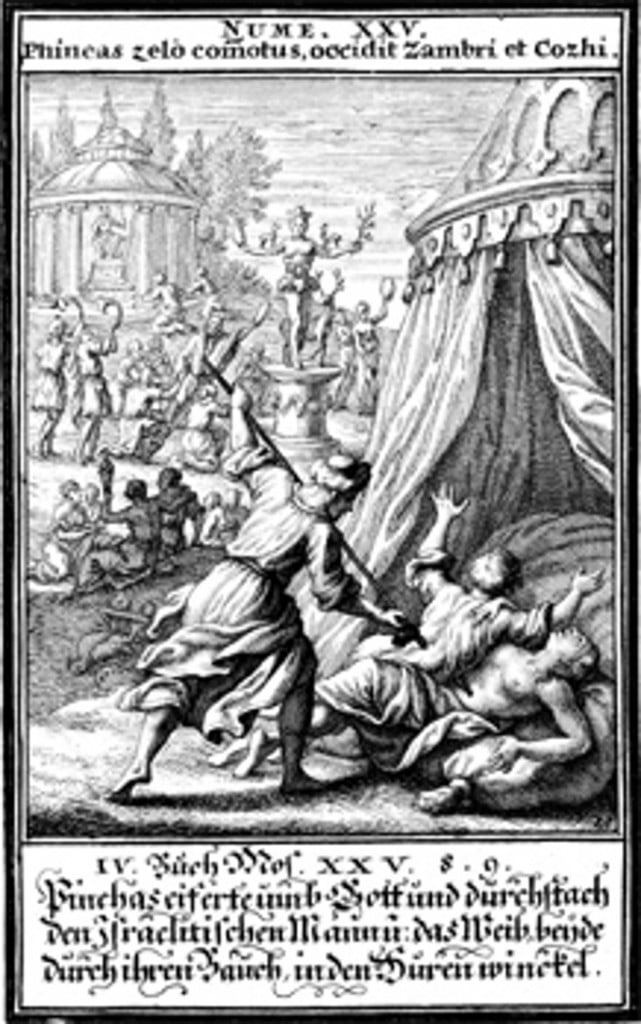A strange episode at the end of the last Torah portion, Balak, where Phinehas (Pinchas) slain a Jewish prince caught in the act with a heathen woman, is rewarded in this week’s eponymous Torah portion with the priesthood. This begs the question, what is the connection between the act of zealotry by Phinehas and the reward of priesthood he receives for it?
By way of background, as we read in the previous Torah portion, the evil king, Balak, fails to bring a curse on the Jewish people by Balaam (Bilam). According to Midrash, Balaam advises Balak to send most beautiful Midian women to seduce Jewish men (see Flavius Josephus’s Antiquities of the Jews, Book IV, Chapter VI, Paragraphs 6-12). Balak heads the advice and uses Moabite and Midianite women to seduce Jewish men who promptly fall into the trap. Comingling with Moabite and Midianite women, Jewish men began to worship the idol of Baal-peor. The plague breaks out among Jews.
Jews were chosen by G‑d to be His holy nation. “Ye shall be holy; for I, the Lord, your G‑d, am holy,” says G‑d to the Jewish nation (Leviticus 19:2). As I explained in my earlier post, Ye Shall be Disentangled, holy (kadosh in Heb.) means separated. As one of the consequences of this injunction, Jews may not get entangled with heathen nations through sexual union. Sexual immorality with Midianite women eroded the boundaries of separation and entangled the holy nation with a heathen nation. This had catastrophic consequences killing twenty-four thousands of Jews in a plague. The whole nation was thrown in an untenable state of superposition of holy and unholy.
When a Jewish prince, Zimri, brings a Midianite princess, Cozbi (Kozbi) into his tent in front of Moses and the elders of Israel and cohabits with her, Moses is uncertain of what to do. This uncertainty may very well be the result of the spiritual decline of the entire nation due to sexual immorality. Pinchas takes a spear and pierces this cloud of uncertainty (characteristic of the wavefunction before it is collapsed) by piercing man and the woman engaged in a sexual act, thereby collapsing the wavefunction, as it were. This ended the plague and restored the sanctity of the holy nation. Thus far is the last Torah portion, Balak (Num. 25).
In this Torah portion, Phinehas is rewarded with priesthood – the only time in history when the priesthood (kehunah) was given to someone who has not inherited it. Why? What is it in the job description of a kohen (priest) that Phinehas had a particular talent and qualification for? Aside from ministering to G‑d and performing service in the Temple, an important function of a kohen was to declare people, houses and objects afflicted of Tzoras and negoim (spiritual maladies), pure (tahor) or impure (tameh). (See my post “Tumah and Taharah”). Before a priest rules on the status of a person or a house, that person or a house is in a state of superposition of the states of spiritual purity (tahara) and spiritual impurity (tumah). The priest collapses the wavefunction, upon which the person or the house is either pure or impure (and has to go through the process of purification administered by the priest).
By killing the adulterers, and, thereby, collapsing the superposition of holy and unholy, Phinehas demonstrated a unique talent for collapsing the wavefunction the “right” way as it is required of a kohen-priest, thereby earning him and his descendants the priesthood, for which he seemed uniquely qualified.
If knowing how to collapse the wavefunction “the right way” qualifies one for the priesthood, one may be tempted to say that present day’s priests are physicists who study quantum mechanics and know a lot about the wavefunction. Alas, it is not so. No matter how skilled we may be at solving the Schrödinger equation and calculating wavefunction, we have no idea how to affect its collapse. We don’t even know what causes the collapse of the wavefunction or why and how it occurs. We just know that before an experiment, a quantum-mechanical object is described by the wavefunction, whose square amplitude is the probability of finding that object in a given region of space. When we perform a measurement on the object, we find it in a particular place. In other words, the cloud of uncertainty described by the wavefunction collapses into a single point or a certain value that we can measure. The outcome of this collapse is totally random and only obeys the laws of statistics. We have no way of affecting the collapse of the wavefunction and the outcome thereof, which is totally random.
What causes the collapse of the wavefunction, is a subject of considerable debate. Some notable physicists like John Von Neumann, Nobel laureate, Eugene Wigner, John Archibald Wheeler, thought that it is the consciousness of an observer that causes the collapse. According to them, only a conscious observer (called by Wheeler a “participating observer”) can collapse the wavefunction. If it is done by our consciousness, it is done on a subconscious level. It stands to reason that people who have control of their subconscious may be able to affect the collapse of the wavefunction. Hence, we have a Chasidic dictum, trach gut, zain gut! – Think good and shall be good!
As I explained in the previous post, Secrets of the Talking Ass, all miracles are effectuated by collapsing the wavefunction the right way. In my humble opinion, tzadikim – the righteous holy men – are the priests of today. By giving a blessing, a tzadik (a holy man) may be able to affect the future by collapsing the wavefunction “the right way” without breaking laws of nature.


Leave A Comment